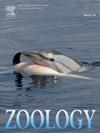Impacts of competition on juveniles of two sympatric freshwater prawn species from Pampean ecosystems: Palaemon argentinus and Macrobrachium borellii
IF 1.6
3区 生物学
Q2 ZOOLOGY
引用次数: 0
Abstract
Competition is an interaction between individuals, either of the same species (intraspecific) or different species (interspecific), involving the contest for limited resources. This interaction can influence individual growth, reproduction, and survival, playing a critical role in regulating population dynamics and modulating community structures. In this study, we assessed the impact of competition type (intraspecific and interspecific) and competition pressure (low and high) on the coexistence of juvenile individuals of two sympatric prawn species commonly found in freshwater environments of South America: Palaemon argentinus and Macrobrachium borellii. To this end, we developed an experimental design to assess how different competition types and pressures affect the survival and growth rates of juveniles of both species, their frequency of use of the provided substrates and shelters, and their priority in obtaining food. The results showed that both the competition type and pressure influenced how these species coexist in experimental aquaria. High-pressure competition affected the survival of both species, with interspecific competition mainly impacting on the survival of P. argentinus and intraspecific competition mainly impacting on the survival of M. borellii. Macrobrachium borellii proved to be the dominant prawn because, under interspecific competition, this species showed higher survival rate, displaced P. argentinus from the spaces and substrates previously used, and secured food before P. argentinus when competitive pressure was high. However, the growth rate of both species was unaffected by either the competition type or pressure. This study provides insights into how competition can influence the ecological dynamics of these sympatric prawn species.
竞争对潘潘亚生态系统两种同域淡水对虾:阿根廷古对虾和波氏沼虾幼虾的影响
竞争是同一物种(种内)或不同物种(种间)个体之间的相互作用,涉及对有限资源的争夺。这种相互作用可以影响个体的生长、繁殖和生存,在调节种群动态和调节群落结构方面起着关键作用。在本研究中,我们评估了竞争类型(种内和种间)和竞争压力(低和高)对南美洲淡水环境中常见的两种同域对虾(Palaemon argentinus和Macrobrachium borellii)幼虾共存的影响。为此,我们开发了一个实验设计,以评估不同的竞争类型和压力如何影响这两个物种的幼鱼的生存和生长速度,它们对所提供的基质和庇护所的使用频率,以及它们获得食物的优先权。结果表明,竞争类型和压力对这些物种在实验水族箱中的共存有影响。高压竞争对两种植物的生存均有影响,种间竞争主要影响阿根廷扁蝽的生存,种内竞争主要影响博雷利扁蝽的生存。在种间竞争中,博氏沼虾表现出更高的成活率,取代了阿根廷沼虾原有的空间和基质,在竞争压力大的情况下,比阿根廷沼虾更早获得食物。然而,两种植物的生长速率都不受竞争类型和压力的影响。这项研究为竞争如何影响这些同域对虾物种的生态动态提供了见解。
本文章由计算机程序翻译,如有差异,请以英文原文为准。
求助全文
约1分钟内获得全文
求助全文
来源期刊

Zoology
生物-动物学
CiteScore
3.90
自引率
0.00%
发文量
37
审稿时长
70 days
期刊介绍:
Zoology is a journal devoted to experimental and comparative animal science. It presents a common forum for all scientists who take an explicitly organism oriented and integrative approach to the study of animal form, function, development and evolution.
The journal invites papers that take a comparative or experimental approach to behavior and neurobiology, functional morphology, evolution and development, ecological physiology, and cell biology. Due to the increasing realization that animals exist only within a partnership with symbionts, Zoology encourages submissions of papers focused on the analysis of holobionts or metaorganisms as associations of the macroscopic host in synergistic interdependence with numerous microbial and eukaryotic species.
The editors and the editorial board are committed to presenting science at its best. The editorial team is regularly adjusting editorial practice to the ever changing field of animal biology.
 求助内容:
求助内容: 应助结果提醒方式:
应助结果提醒方式:


